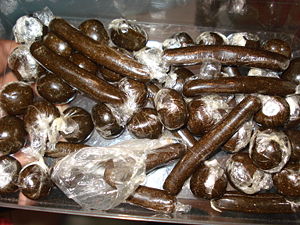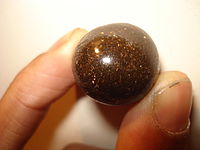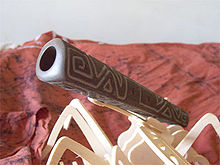- Charas
-
For the film, see Charas (film).
Charas is the name given to a hashish form of cannabis which is hand-made in Afghanistan, Pakistan, Nepal and India. It is made from the resin of the cannabis plant (Cannabis sativa or Cannabis Indica). The plant grows wild throughout Northern India, Pakistan and the Himalayas (its putative origin) and is an important cash crop for the local people.
Contents
History of charas
Hashish has been used across the Indian sub-continent for medicinal and religious purposes for thousands of years,[1] and was sold in government shops (along with opium) during the times of the British Raj and in independant India until the 1980's (marijuana and bhang is still being sold).[2].
Charas plays an important and often integral role in the culture and ritual of certain sects of the Hindu religion, especially among the Shaivs—- the sub-division of Hinduism holding Lord Shiva to be the supreme god (in contrast to Vaishnavs who believe Lord Vishnu as being topmost)-- and it is venerated by some as being one of the aspects of Lord Shiva.
Despite this long history, charas was made illegal in India under US pressure in the 1980s and severe sentences were introduced. Even the mere possession had a mandatory ten year prison sentence. These laws have now been somewhat relaxed; however, charas has remained a popular medium for police to extort money from consumers of the drug.[citation needed]
Even at the peak of the crackdown, charas was still popular and remains so today, especially amongst Indian sadhus. The Naga Sadhus, Aghoris and Tantric Bhairav sects smoke it freely as an integral part of their religious practice. Many smoke it in clay pipes called chillums, using a cotton cloth to cover the smoking end of the chillum and inserting a tightly packed pebble-sized ball of cannabis as filter under the chunk of charas. Before lighting the chillum they will chant the many names of Shiva in veneration. The government even provides a large supply to meet the demand during the largest gathering of sadhus of all sects during the Kumbh mela.[citation needed]However its fast regaining the popularity it once enjoyed with younger generation of India regarding it as a recreational drug of choice.Its freely available in north Indian cities such as Delhi, Chandigarh, Ludhiana for clubbers.
Local cultivation
The best hashish grown in India comes from the mountains. The variety from Kasol and Malana is considered to be of the highest quality throughout India. It is easily available in Shimla, Naldera, Karsog, Narkanda, Kullu & Rampur — practically every area in Himachal Pradesh. For this reason, the Indian subcontinent has become very popular with backpackers and drug smugglers. The best charas, known as "Cream", is made very high up away from the police and can be found in Malana and Kasol area Of Himachal.
During hand-harvesting the resin sticks to one's palms and by the end of the day one has perhaps 8 or 9 grams of charas. The faster one works, the lower the quality of charas; hence to make "Malana cream" it is necessary to go very slowly and make only a few grams a day. Nowadays production of cannabis in the Himalayas has increased with growing demand for Malana cream; the ancient art of manufacturing is disappearing under the pressure to capitalize on the domestic and international market for charas.
High quality charas was also produced in Nepal and sold in government monopoly stores in Kathmandu until the government gave in to international pressure and got out of the business in the 1970s. Rolpa district in western Nepal was a production center, with ganja and charas both an important cash crop in this extremely isolated, underdeveloped and impoverished region.
Gardaa
Gardaa is a type of hashish made primarily in Afghanistan, but also in Pakistani tribal areas, using dried cannabis of high potency. It is a very pure form of Charas; free from any additive chemicals. It is a very pliable substance which can take any shape. Usually sold in the shape of balls, Gardaa starts dissolving into smaller particles even with the heat of the palm. Gardaa is an Urdu word which means "dust". It is named Gardaa due to its similarity in colour to mud or brown thick dust. Charas is mostly consumed after it is heated. After it is heated, the "brown powder" changes into a smooth "greenish mass". The term gardaa is also some times used to describe the greenish powder-form of charas. Gardaa has two types mainly, one is soft, solid, smooth structure known as pakka garda and the other one is kacha gardaa, kacha gardaa is a soft powder which is green (or lightly green brown sometimes).
Although gardaa is available throughout Pakistan, it is made in the northern tribal areas of Pakistan and in Afghanistan. It is mainly available in Peshawar, and even though the smell may linger in bazaars, it is not sold openly—though with a help of a guide one can find it. In N-W.F.P., It can mostly be found in those areas which lie on the border with Khyber Agency and Kurram Agency. One such place is Shah Kass which is part of Khyber Agency and borders with the Hayatabad neighborhood of Peshawar city. One "tola" on average costs 600 Pakistani Rupees. Its price has increased due to the tension in the Tribal Areas.
Mixtures with tobacco[3]
Gardaa is smoked, usually mixed with cigarette tobacco and rolled back into the cigarette blank. Cigarettes that burn longer due to cigarette paper/tobacco qualities are preferred for mixing and smoking Gardaa. To smoke Gardaa in a Cigarette, Cigarette tobacco is taken out and refined using hands to make it into smaller particles. Tobacco leaves with less moisture are easier to crush. Gardaa is then heated to make it soft; this is often referred to as "cooking". The objective is to dissolve the Gardaa in the tobacco to make a mix while wasting minimum smoke value (meaning heated only enough to make it soft without burning it into smoke). Once mixed with the tobacco using hands it is filled back into the cigarette blank. The cigarette is tightly filled back to ensure maximum smoke in each puff. The cigarette commonly used is Cavenders cigarette, preferred because it is filterless.
Rolling paper is also used to smoke Gardaa. Gardaa with tobacco mixture is filled into the rolling paper to make a joint.
Gardaa production in Kashmir
In the Indian administered part of Kashmir, Gardaa is made from dried cannabis leaves of low quality. They put the material into a cornleaf, by twisting the leaf the material is being pressed in the shape of a corkscrew. After some weeks or months of fermentation the unwrapped product is sold in its typical twisted shape but now in strong consistence for only half the price of charas. The colour ranges from green to brown, depending on the quality.It may have bits of sand in it because it is often dug into the ground for fermentation.
Differences with Hashish from Middle East, North Africa and Central Asia
Hashish from Lebanon, Morroco and other countries in the Middle East and Central Asia is prepared in a different way, mostly by sieving dried male (pollen) and female cannabis plants over a gauze or fine sieve. The fine powder is then filled into plastic (or cotton) pouches and heat ironed into compressed bricks or plates, ready to be exported. If no iron is available, the powder is filled into plastic pouches, then wrapped in some layers of newspaper and then rolled with a bottle over a hot griddle or pan. However, what is smoked locally is much similar to black charras or gardaa and is sometimes called sputnik, for it's less tiresome effect compared to the regular green or red export hashish. The tiresome effect is believed to come from the amount of leaf matter that adulterates the export hashish, but may also be due to the presence of male pollen. The similar (inferiour) kind of Hashish is also found in the cannabis steppes from Kazakhstan to Western China (Xinjiang). It is sometimes sold in it's uncompressed form as yellow "pollen".
References
- ^ "If Drugs Were Legal, Scarlett Might Be Alive". The Times of India, 14 March 2008.
- ^ Report of the Indian Hemp Drugs Commission, 1893–94. Simla, India: Government Central Printing House, 1894, 7 vols., CHAPTER XIV. THE POLICY OF HEMP DRUG ADMINISTRATION
- ^ Australian Government Department of Health: National Cannabis Strategy Consultation Paper, p. 4. "Cannabis has been described as a 'Trojan Horse' for nicotine addiction, given the usual method of mixing Cannabis with tobacco when preparing marijuana for administration."
Cannabis General Preparations Usage Effects Short-term · Long-term (dependence · withdrawal · respiratory disease) · Cannabidiol · Cannabinoids · Delta-9-tetrahydrocannabinol (Δ9-THC) · Endocannabinoid systemNotable strains Acapulco Gold · BC Bud · Holland's Hope · G-13 · Kush · Netherlands Weed · Northern Lights · Panama Red · Quebec Gold · Skunk · White WidowOrganizations Culture Categories:- Entheogens
- Cannabis
- Cannabis smoking
Wikimedia Foundation. 2010.



